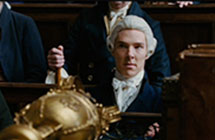涨知识!英国法官和律师的白色假发原来大有来头
|
In England wigs remain an important part of formal courtroom attire for judges and barristers — the term there for lawyers. Many of the judges and barristers who wear wigs in court say the headpiece — also known as a peruke — brings a sense of formality and solemnity to proceedings. Like many uniforms, wigs are an emblem of anonymity, an attempt to distance the wearer from personal involvement and a way to visually draw on the supremacy of the law, says Kevin Newton, a Washington, D.C.-based lawyer who studied law at the University of London. Wigs are so much a part of British criminal courts that if a barrister doesn't wear a wig, it's seen as an insult to the court.
法官和律师佩戴的假发一样吗? Barristers must wear a wig slightly frizzed at the crown, with horizontal curls on the sides and back. In addition, there are two long strips of hair that hang down below the hairline on the neck and sport a looped curl at each end. Different types of lawyers, though, have distinctions in the style of wig. A judge's wig is similar, but more ornate. It's a full wig, from a slightly frizzed top that transitions into tight horizontal curls that range several inches below the shoulders.
Most wigs are made of white horse hair, but as a wig yellows with age, it takes on a coveted patina that conveys experience. Horse hair may not seem like a particularly precious material, but pair specialty hair with an age-old craft of styling, sewing and gluing, and the resulting wigs aren't cheap. A judge's full-length wig can cost more than $3,000, while the shorter ones worn by barristers cost more than $500. 假发为何开始流行? Wigs may have fallen out of general men's fashion over the centuries, but when wigs first made their appearance in a courtroom, they were part and parcel of being a well-dressed professional. In the 17th century, only the elite wore powdered wigs made of horsehair. Those who couldn't afford the elite garb but wanted to look the part wore wigs made of hair from goats, spooled cotton or human corpses. Wigs began to catch on in the late 16th century when an increasing number of people in Europe were contracting the STD. Without widespread treatment with antibiotics, people with syphilis were plagued by rashes, blindness, dementia, open sores and hair loss. The hair loss was particularly problematic in social circles. Wigs, when not used to cover syphilis-related hair loss, were a big help for those who had lice. After all, it was much more difficult to treat and pick through the hair on one's head than it was to sanitize a wig. Over time, wigs fell out of fashion with society as a whole. During the reign of England's King George III, from 1760 to 1820, wigs were worn by only a few — namely bishops, coachmen and those in the legal profession. And bishops were permitted to stop wearing them in the 1830s. But the courts kept wigs for hundreds of years more. In 2007, though, new dress rules did away with barrister wigs — for the most part. Wigs were no longer required during family or civil court appearances, or when appearing before the Supreme Court of the United Kingdom. Wigs, however, remain in use in criminal cases. In the U.K. and Ireland, judges continued to wear wigs until 2011, when the practice was discontinued. In England, and other former English and British colonies — like Canada, for instance, whose provinces abandoned the wigs throughout the 19th and 20th centuries, or Jamaica which removed the wigs in 2013 — lawyers and judges now only wear wigs for ceremonies. |









